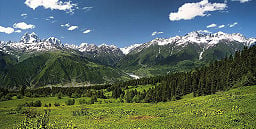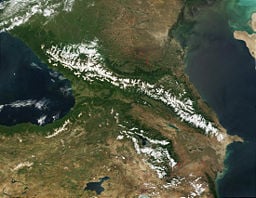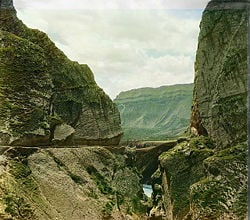Caucasus Mountains
| Caucasus Mountains | |
| Range | |
Svaneti region, North-Western Georgia
| |
| Countries | Russia, Georgia, Azerbaijan, Armenia |
|---|---|
| Highest point | Mount Elbrus |
| - elevation | 5,642 meters (18,510 feet) |
| - coordinates | |
| Length | 1,100 km (684 miles) |
| Width | 160 km (99 miles) |
The Caucasus Mountains is a mountain system in Eurasia between the Black and the Caspian sea in the Caucasus region.
The Caucasus Mountains are made up of three separate mountain systems:
- the Greater Caucasus Mountain Range and
- the Middle Caucasus Mountain Range and
- the Lesser Caucasus Mountains.
The Greater Caucasus Range extends from the Caucasian Natural Reserve in the vicinity of Sochi on the northeastern shore of the Black Sea, generally trending east-southeast and reaching nearly to Baku on the Caspian Sea, while the Lesser Caucasus runs parallel to the greater range, at a distance averaging about 100 km (60 mi) south. Meskheti Range is a part of the Lesser Caucasus system. The Greater and Lesser Caucasus ranges are connected by the Likhi Range, which separates the Kolkhida Lowland from the Kura Depression (Kura Lowland). In the South-East are the Talysh Mountains. The Lesser Caucasus and the Armenian Highland constitute the Transcaucasian Highland. The highest peak in the Caucasus range is Mount Elbrus in the Greater Caucasus, which rises to a height of 18,506 feet (5,642 meters) above sea level. Mountains near Sochi will host part of the 2014 Winter Olympics.
Geology
The Caucasus Mountains formed ca. 28.49–23.8 million years ago as the result of a tectonic plate collision between the Arabian plate moving northward with respect to the Eurasian plate. The mountain system forms a continuation of the Himalayas, which are being pressed upwards by a similar collision zone with the Eurasian and Indian plates. The entire region is regularly subjected to strong earthquakes from this activity, especially as the fault structure is complex with the Anatolia/Turkey and Iranian Blocks flowing sidewise, which prevents subduction of the advancing plate edge and hence the lack of volcanoes on the Greater Caucasus Mountain Range (although stratovolcanoes such as Mount Elbrus, Mount Kazbek and others do exist). The Lesser Caucasus Mountains on the other hand, are largely of volcanic origin. The Javakheti Volcanic Plateau in Georgia and the surrounding volcanic ranges which extend well into central Armenia are some of the youngest and the most unstable geological features of the region.
There are large granite, gneiss, petroleum (estimated reserves: up to 200 billion barrels) and numerous natural gas deposits found in the area.
Geographical affiliation
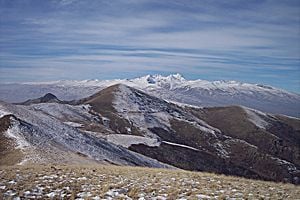
There is no clear agreement on whether the Caucasus Mountains are a part of Europe or Asia. Depending on the varying perspectives, Europe's highest mountain is either Mount Elbrus 5,642 m (18,510.5 ft) or Mont Blanc in the Alps, at the Italian-French border, with a height of 4,810 m (15,780.8 ft).
The Caucasus Mountains are located in the middle of the Eurasian plate between Europe and Asia. Because the plate is geologically stable in this region, it is hard to determine the exact course of the continental borderline. Therefore, throughout history the borderline has changed from one place to another. The ancient Greeks saw the Bosporus and the Caucasus Mountains as the border of Europe. Later this view changed several times for political reasons. In the Migration Period and the Middle Ages, Bosporus and the river Don divided the two continents.
The border was historically defined by the Swedish military officer and geographer Philip Johan von Strahlenberg, who suggested the border follow the peaks of the Urals, and then the lower Emba and the coast of the Caspian Sea, before passing through the Kuma-Manych Depression, which lies 300 km north of the Caucasus Mountains. In 1730, this course was approved by the Russian Tsar and since that time has been adopted by many scientists. Following this definition, the mountains are a part of Asia and according to this view, the highest European mountain is Mont Blanc.
On the other hand, La Grande Encyclopédie clearly draws the border between Europe and Asia south of both Caucasian mountain ranges. Both Elbrus and Kazbek are here European mountains.
In political terms, the present-day division is either considered to be between Russia (Europe) on one side and Georgia, Armenia and Azerbaijan (Asia) on the other, inclusive of Georgia and Azerbaijan within Europe but not Armenia, or inclusive of all three nations.
Notable peaks
The table below lists some of the highest peaks of the Caucasus. With the exception of Shkhara, the heights are taken from Soviet 1:50,000 mapping. There are higher and more prominent, but nameless, peaks than some of the peaks included below.
| Peak Name | Elevation (m) | Prominence (m) | Country |
|---|---|---|---|
| Elbrus | 5,641 | 4,741 | Russia |
| Dykh-Tau | 5,205 | 2,002 | Russia |
| Shkhara | 5,201 | 1,365 | Georgia |
| Koshtan-Tau | 5,152 | 822 | Russia |
| Jangi-Tau (Janga) | 5,059 | 300 | Russia/Georgia |
| Kazbek | 5,047 | 2,353 | Georgia |
| Pushkin | 5,033 | 110 | Russia/Georgia |
| Katyn-Tau | 4,979 | 240 | Russia/Georgia |
| Shota Rustaveli | 4,860 | c.50 | Georgia |
| Tetnuld | 4,858 | 672 | Georgia |
Climate
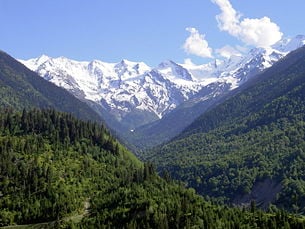
The climate of the Caucasus varies both vertically (according to elevation) and horizontally (by latitude and location). Temperature generally decreases as elevation rises. Average annual temperature in Sukhumi, Abkhazia at sea level is 15 degrees Celsius while on the slopes of Mt. Kazbek at an elevation of 3700 meters, average annual temperature falls to -6.1 degrees Celsius. The northern slopes of the Greater Caucasus Mountain Range are 3 degrees (Celsius) colder than the southern slopes. The highlands of the Lesser Caucasus Mountains in Armenia, Azerbaijan, and Georgia are marked by sharp temperature contrasts between the summer and winter months due to a more continental climate.
Precipitation increases from east to west in most areas. Elevation plays an important role in the Caucasus and mountains generally receive higher amounts of precipitation than low-lying areas. The northeastern regions (Dagestan) and the southern portions of the Lesser Caucasus Mountains are the driest. The absolute minimum annual precipitation is 250mm (8.4 inches) in the northeastern Caspian Depression. Western parts of the Caucasus Mountains are marked by high amounts of precipitation. The southern slopes of the Greater Caucasus Mountain Range receive higher amounts of precipitation than the northern slopes. Annual precipitation in the Western Caucasus ranges from 1000-4000mm (39-157 inches) while in the Eastern and Northern Caucasus (Chechnya, Ingushetia, Kabardino-Balkaria, Ossetia, Kakheti, Kartli, etc) precipitation ranges from 600-1800mm (23.6-70.9 inches). The absolute maximum annual precipitation is 4100mm (161 inches) around the Mt. Mtirala area which lies on the Meskheti Range in Ajaria. The precipitation of the Lesser Caucasus Mountain Range (Southern Georgia, Armenia, western Azerbaijan), not including the Meskheti Range, varies from 300-800mm (11.8-31.5 inches) annually.
The Caucasus Mountains are known for their high amount of snowfall, although many regions which are not located along the windward slopes do not receive nearly as much snow. This is especially true for the Lesser Caucasus Mountains which are somewhat isolated from the moist influences coming in from the Black Sea and receive considerably less precipitation (in the form of snow) than the Greater Caucasus Mountains. The average winter snow cover of the Lesser Caucasus Mountains ranges from 10-30cm (4-12 inches). The Greater Caucasus Mountains (especially the southwestern slopes) are marked by heavy snowfall. Avalanches are common from November through April.
Snow cover in several regions (Svanetia, northern Abkhazia ) may reach 5 meters (16.4 feet). The Mt. Achishkho region, which is the snowiest place in the Caucasus, often records snow depths of 7 meters (23 feet).
Landscape
The Caucasus Mountains have a varied landscape which mainly changes vertically and according to the distance from large bodies of water. The region contains biomes ranging from subtropical low-land marshes/forests to glaciers (Western and Central Caucasus) as well as highland semideserts/steppes and alpine meadows in the south (mainly Armenia and Azerbaijan).
The northern slopes of the Greater Caucasus Mountains are covered by oak, hornbeam, maple, and ash forests at lower elevations while birch and pine forests take over at higher elevations. Some of the lowest locations/slopes of the region are covered by steppes and grasslands. The slopes of the Northwestern Greater Caucasus (Kabardino-Balkaria, Cherkessia among others) also contain spruce and fir forests. The alpine zone replaces the forest around 2,000 meters above sea level. The permafrost/glacier line generally starts around 2,800-3,000 meters. The southeastern slopes of the Greater Caucasus Mountains are covered by beech, oak, maple, hornbeam, and ash forests. Beech forests tend to dominate in higher locations. The southwestern slopes of the Greater Caucasus are covered by Colchian forests (oak, buxus, beech, chestnut, hornbeam, elm) at lower elevations with coniferous and mixed forests (spruce, fir and beech) taking over at higher elevations. The alpine zone on the southern slopes may extend up to 2,800 meters above sea level while the glacier/snow line starts from 3,000-3,500 meters.
The northern and western slopes of the Lesser Caucasus Mountains are characterized both by Colchian and other deciduous forests at lower elevations while mixed and coniferous forests (mainly spruce and fir) dominate at higher elevations. Beech forests are also common at higher elevations. The southern slopes of the Lesser Caucasus Mountains are largely covered by grasslands and steppes up to an elevation of 2,500 meters. The highest areas of the region contain alpine grasslands as well.
Volcanic and other rock formations are common throughout the region. The volcanic zone extends over a large area from southern Georgia into Armenia and southwestern Azerbaijan. Some of the prominent peaks of the region include Mt. Aragats, Didi Abuli, Samsari, and others. The area is characterized by volcanic plateaus, lava flows, volcanic lakes, volcanic cones and other features. The Lesser Caucasus Mountains lack the type of glaciers/glacial features that are common on the Greater Caucasus Mountain Range.
ReferencesISBN links support NWE through referral fees
- Cornell, Svante E. 2001. Small nations and great powers: a study of ethnopolitical conflict in the Caucasus. Caucasus world. Richmond, Surrey, England: Curzon. ISBN 9780700711628
- Krussanov, Andrej, Robin Collomb, and Andrew Wielochowski. 1994. Map & guide to the Caucasus Mountains: Bashil-Chegem, Bezingi-Adai Khokh, topographical. Worthing u.a: EWP. ISBN 9780906227534
- NASA Earth Observatory. Mt. Elbrus Retrieved December 20, 2008.
- Peakbagger.com. Caucasus Mountains Retrieved December 20, 2008.
External links
- NASA Earth Observatory. Visible Earth images of the Caucasus Retrieved December 20, 2008.
Coordinates:
Credits
New World Encyclopedia writers and editors rewrote and completed the Wikipedia article in accordance with New World Encyclopedia standards. This article abides by terms of the Creative Commons CC-by-sa 3.0 License (CC-by-sa), which may be used and disseminated with proper attribution. Credit is due under the terms of this license that can reference both the New World Encyclopedia contributors and the selfless volunteer contributors of the Wikimedia Foundation. To cite this article click here for a list of acceptable citing formats.The history of earlier contributions by wikipedians is accessible to researchers here:
The history of this article since it was imported to New World Encyclopedia:
Note: Some restrictions may apply to use of individual images which are separately licensed.
